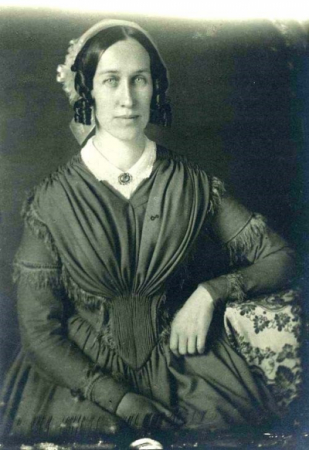Clarina Nichols

Grace Carpenter Hudson’s Grandmother
The Forgotten Feminist of Kansas,
Kansas Historical Quarterly, Summer 1973 The Papers of Clarina I. H. Nichols, 1854-1885.
———–
Clarina’s bio: https://www.wikitree.com/wiki/Howard-12279
CLARINA HOWARD NICHOLS
(1810-1885)
Clarina Irene was the first born of Chapin and Birsha Howard’s eight children, growing up in Townshend, Vermont. In her teens, she asked her father for an education instead of a dowry, and thus received one year of “academy” training following her primary schooling. After graduation, she taught for two years. At age 20, Clarina married Justin Carpenter, moving with him to western New York state.
Quickly bearing three children, Clarina struggled to help support her family by teaching, as Justin’s business attempts failed to sustain them. Separating from him in 1839, she returned with her children to her parents’ home in Townshend. There she found work as a writer on the Windham County Democrat, edited and published by George W. Nichols, a widower more than 25 years her senior.
In 1843 her divorce from Justin finalized, she immediately married George. Within a year Clarina had born her fourth child, George Bainbridge, and was quietly running her husband’s newspaper behind the scenes, as his health failed him. The newspaper gave Clarina a forum to express her growing support of current social reforms, in particular those of temperance, abolition, and women’s rights. She now began organizing women’s rights conventions throughout the east, and became a much sought-after speaker.
In 1854, Nichols joined the “free soil emigrants” settling Kansas Territory, in part to secure a milder climate for her husband, and gain opportunity for her sons, but also to work towards a government of “equality, liberty, fraternity” from the ground up in the state-to-be. However, her weakened husband died within a year of their arrival, and son Aurelius left for California with his wife’s family in 1857. Despite these losses, she worked tirelessly for the causes of abolition and women’s rights in Kansas, only relocating briefly to Washington, D.C. for a few years during the Civil War.
At age 61, partly to escape harsh Kansas winters, she migrated to Potter Valley with her youngest son George, his Wyandotte Indian wife, Mary, and their three children. After Mary’s death in 1873, Clarina helped raise George’s children, while continuing extensive writing campaigns supporting her many causes. She remained a nationally recognized voice for women’s rights throughout her later years, and in truth paved the way for many of the civil liberties that women in this country now enjoy.
Text provided by and courtesy of the Grace Hudson Museum
Clarina is buried with her son, George B Nichols
Mary W. Nichols -his wife
Birney A.- his daughter
Catherine H. Raymond- Georges daughter
Helen C. Moncrief -Georges daughter
Harry Moncrief – Helen’s husband
